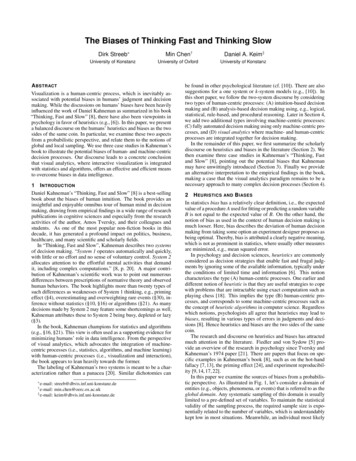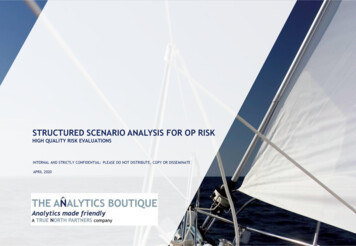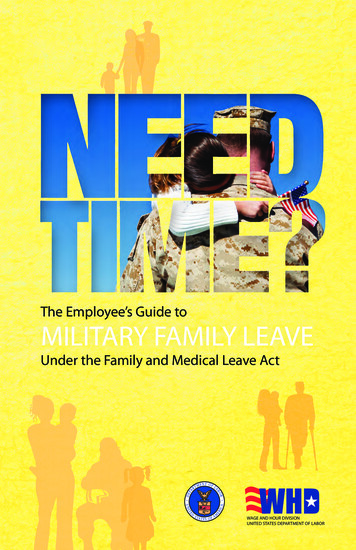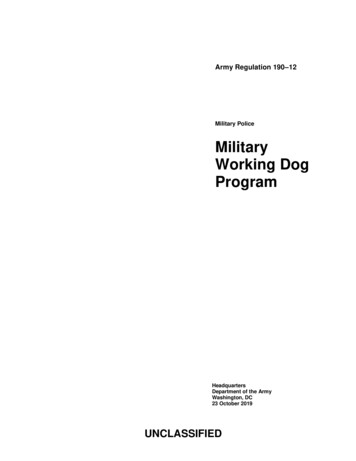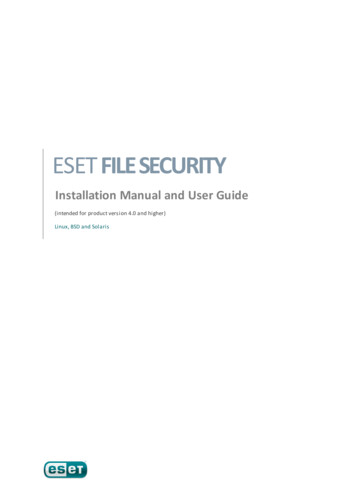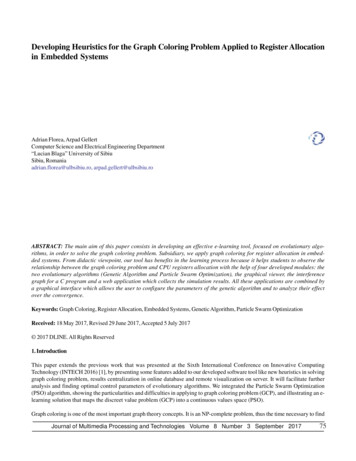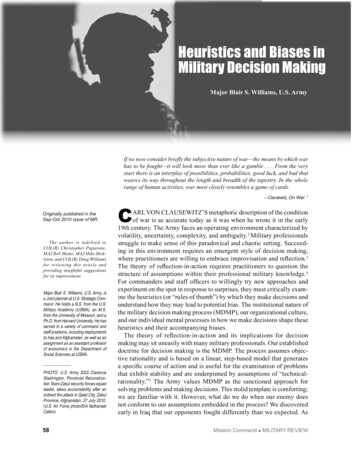
Transcription
Heuristics and Biases inMilitary Decision MakingMajor Blair S. Williams, U.S. ArmyIf we now consider briefly the subjective nature of war—the means by which warhas to be fought—it will look more than ever like a gamble . . . From the verystart there is an interplay of possibilities, probabilities, good luck, and bad thatweaves its way throughout the length and breadth of the tapestry. In the wholerange of human activities, war most closely resembles a game of cards.—Clausewitz, On War. 1Originally published in theSep-Oct 2010 issue of MR.The author is indebted toCOL(R) Christopher Paparone,MAJ Rob Meine, MAJ Mike Shekleton, and COL(R) Doug Williamsfor reviewing this article andproviding insightful suggestionsfor its improvement.Major Blair S. Williams, U.S. Army, isa Joint planner at U.S. Strategic Command. He holds a B.S. from the U.S.Military Academy (USMA), an M.S.from the University of Missouri, and aPh.D. from Harvard University. He hasserved in a variety of command andstaff positions, including deploymentsto Iraq and Afghanistan, as well as anassignment as an assistant professorof economics in the Department ofSocial Sciences at USMA.PHOTO: U.S. Army SSG ClarenceWashington, Provincial Reconstruction Team Zabul security forces squadleader, takes accountability after anindirect fire attack in Qalat City, ZabulProvince, Afghanistan, 27 July 2010.(U.S. Air Force photo/SrA NathanaelCallon)58CARL VON CLAUSEWITZ’S metaphoric description of the conditionof war is as accurate today as it was when he wrote it in the early19th century. The Army faces an operating environment characterized byvolatility, uncertainty, complexity, and ambiguity.2 Military professionalsstruggle to make sense of this paradoxical and chaotic setting. Succeeding in this environment requires an emergent style of decision making,where practitioners are willing to embrace improvisation and reflection.3The theory of reflection-in-action requires practitioners to question thestructure of assumptions within their professional military knowledge.4For commanders and staff officers to willingly try new approaches andexperiment on the spot in response to surprises, they must critically examine the heuristics (or “rules of thumb”) by which they make decisions andunderstand how they may lead to potential bias. The institutional nature ofthe military decision making process (MDMP), our organizational culture,and our individual mental processes in how we make decisions shape theseheuristics and their accompanying biases.The theory of reflection-in-action and its implications for decisionmaking may sit uneasily with many military professionals. Our establisheddoctrine for decision making is the MDMP. The process assumes objective rationality and is based on a linear, step-based model that generatesa specific course of action and is useful for the examination of problemsthat exhibit stability and are underpinned by assumptions of “technicalrationality.”5 The Army values MDMP as the sanctioned approach forsolving problems and making decisions. This stolid template is comforting;we are familiar with it. However, what do we do when our enemy doesnot conform to our assumptions embedded in the process? We discoveredearly in Iraq that our opponents fought differently than we expected. AsMission Command MILITARY REVIEW
SPECIAL EDITIONa result, we suffered tremendous organizationaldistress as we struggled for answers to the insurgency in Iraq. We were trapped in a mental caveof our own making and were unable to escape ourpreconceived notions of military operations anddecision making.6Fortunately, some have come to see the shortcomings of the classical MDMP process. It is illsuited for the analysis of problems exhibiting highvolatility, uncertainty, complexity, and ambiguity.The Army’s nascent answer, called “Design,”looks promising. As outlined in the new versionof FM 5-0, Operations Process, Chapter 3, Designis defined as “a methodology for applying criticaland creative thinking to understand, visualize, anddescribe complex, ill-structured problems anddevelop approaches to solve them.”7 Instead of auniversal process to solve all types of problems(MDMP), the Design approach acknowledgesthat military commanders must first appreciatethe situation and recognize that any solution willbe unique.8 With Design, the most important taskis framing a problem and then reframing it whenconditions change.9Framing involves improvisation and on-thespot experimentation, especially when we facetime and space constraints in our operating environment. FM 6-0, Mission Command, Chapter 6,states, “Methods for making adjustment decisionsfall along a continuum from analytical to intuitive . . . As underlying factors push the methodfurther to the intuitive side of the continuum,at some point the [planning] methodology nolonger applies.”10 In the course of intuitive decision making, we use mental heuristics to quicklyreduce complexity. The use of these heuristicsexposes us to cognitive biases, so it is importantto ask a number of questions.11 What heuristicsdo we use to reduce the high volatility, uncertainty, complexity, and ambiguity, and how dothese heuristics introduce inherent bias into ourdecision making? How do these biases affectour probabilistic assessments of future events?Once apprised of the hazards rising from theseheuristic tools, how do we improve our decisions? This article explores these questionsand their implications for the future of militarydecision making.Behavioral EconomicsThe examination of heuristics and biases beganwith the groundbreaking work of Nobel LaureateDaniel Kahneman and Professor Amos Tversky.Dissatisfied with the discrepancies of classicaleconomics in explaining human decision making,Kahneman and Tversky developed the initialtenets of a discipline now widely known as behavioral economics.12 In contrast to preexisting classical models (such as expected utility theory) whichsought to describe human behavior as a rationalmaximization of cost-benefit decisions, Kahneman and Tversky provided a simple frameworkof observed human behavior based upon choicesunder uncertainty, risk, and ambiguity. They proposed that when facing numerous sensory inputs,human beings reduce complexity via the use ofheuristics. In the course of these mental processesof simplifying an otherwise overwhelming amountof information, we regularly inject cognitive bias.Cognitive bias comes from the unconscious errorsgenerated by our mental simplification methods.It is important to note that the use of a heuristicdoes not generate bias every time. We are simplymore prone to induce error. Additionally, thisbias is not cultural or ideological bias—both ofwhich are semi-conscious processes.13 Kahneman and Tversky’s identified phenomena havewithstood numerous experimental and real-worldtests. They are considered robust, consistent, andpredictable.14 In this article, we will survey threeimportant heuristics to military decision making:availability, representativeness, and anchoring.15In the course of intuitive decision making, we use mental heuristics to quickly reduce complexity. The use of these heuristicsexposes us to cognitive biases MILITARY REVIEW Mission Command59
US Marine Corps photo by Lance CPL Abby Burtne.U.S. Marine Corps SSgt Tommy Webb of Headquarters Battalion, Marine Forces Reserve, teaches a class on grid coordinates and plotting points on a map, 22 February 2010. The course emphasizes combat conditioning, decision making,critical thinking skills, military traditions, and military drill. These professional courses must focus on critical reflectionwhen examining new problems in order to avoid bias.AvailabilityWhen faced with new circumstances, peoplenaturally compare them to similar situations residing in their memory.16 These situations often “cometo one’s mind” automatically. These past occurrences are available for use, and generally, theyare adequate for us to make sense of new situationsencountered in routine life. However, they rarely arethe product of thoughtful deliberation, especially ina time-constrained environment. These availablerecollections have been unconsciously predetermined by the circumstances we experienced whenwe made them. These past images of like circumstances affect our judgment when assessing riskand/or the probability of future events. Ultimately,four biases arise from the availability heuristic:retrievability bias, search set bias, imaginabilitybias, and illusory correlation.Retrievability bias. The frequency of similarevents in our past reinforces preconceived notionsof comparable situations occurring in the future.For example, a soldier will assess his risk of beingwounded or killed in combat based on its frequency60of occurrence among his buddies. Likewise, an officer may assess his probability of promotion basedon the past promotion rates of peers. Availabilityof these frequent occurrences helps us to quicklyjudge the subjective probability of future events;however, availability is also affected by other factors such as salience and vividness of memory. Forexample, the subjective probability assessment offuture improvised explosive device (IED) attackswill most likely be higher from a lieutenant whowitnessed such attacks than one who read aboutthem in situation reports. Bias in their assessmentoccurs because the actual probability of futureattacks is not related to the personal experience ofeither officer.17Similarly, consistent fixation on a previous eventor series of events may also increase availability.18Naval officers most likely experienced a temporaryrise in their subjective assessment of the risk ofship collision after the highly publicized reports ofthe collision between the USS Hartford and USSNew Orleans.19 The true probability of a futurecollision is no more likely than it was prior to theMission Command MILITARY REVIEW
SPECIAL EDITIONcollision, yet organizational efforts to avoid collisions increased due to the subjective impressionthat collisions were now somehow more likely.People exposed to the outcome of a probabilisticevent give a much higher post-event subjectiveprobability than those not exposed to the outcome.This is called hindsight bias.When combining hindsight bias and retrievability biases, we potentially fail to guard against anevent popularized euphemistically as a black swan.Nassim Taleb describes black swans as historicalevents that surprised humanity because they werethought of as non-existent or exceedingly rare. Weassume all swans are white; they are in our available memory.20 For example, in hindsight the 11September 2001 terrorist attacks look completelyconceivable; therefore, we hold the various intelligence agencies of the U.S. government publiclyaccountable for something that was not even considered plausible before the event. Furthermore,mentally available disasters set an upper boundon our perceived risk. Many of our precautionaryhomeland security measures are based on stoppinganother 9/11 type attack, when in fact the nextattempt may take on a completely different contextthat we cannot imagine (because our searches forpast experiences are limited).21Availability played a role in the current globalfinancial crisis. Our collective memories containedtwo decades of stable market conditions. Theinability to conceive a major economic downturnand the flawed assumption that systemic risk to thenational real estate market was minuscule contributed to creating a black swan event.22 Taleb wrotethe following passage before the collapse of theasset-backed securities market (a major element ofthe current economic recession):Globalization creates interlocking fragility, while reducing volatility and giving theappearance of stability. In other words, itcreates devastating Black Swans. We havenever lived before under the threat of aglobal collapse. Financial institutions havebeen merging into a smaller number of verylarge banks. Almost all banks are interrelated. So the financial ecology is swellinginto gigantic, incestuous banks—when onefails, they all fail. The increased concentration among banks seems to have the effectMILITARY REVIEW Mission Commandof making financial crises less likely, butwhen they happen they are more global inscale and hit us very hard.23Given the possibility of black swans, we shouldconstantly question our available memories whenfaced with new situations. Are these memoriesleading us astray? Are they making our decisionsmore or less risky? Are our enemies exploiting thisphenomenon? Military planners have done so in thepast, seeking the advantage of surprise.For example, the British were masters at exploiting retrievability biases during World War II. Theyemployed the COLLECT plan in North Africain 1941 to obfuscate the exact timing of GeneralAuchinleck’s offensive (Operation Crusader)against Rommel’s forces in Libya.24 Via official,unofficial, and false channels, the British repeatedlysignaled specific dates of the commencement of theoperation, only to rescind these orders for plausiblereasons. These artificial reasons included the inability to quickly move forces from Syria to take partin the operation to the failure of logistics ships toarrive in Egypt. Planners wanted to lull Rommelinto expecting the repeated pattern of preparationand cancellation so that when the actual operationbegan, his memory would retrieve the repeatedpattern. The plan worked. The British achievedoperational deception. They surprised Rommel andafter 19 days of fighting ultimately succeeded inbreaking the siege at Tobruk. The repetitive natureof orders and their cancellation demonstrates thepower of availability on human decision making.25Search Set Bias. As we face uncertainty in piecingtogether patterns of enemy activity, the effectivenessof our patterns of information retrieval constrain ourability to coherently create a holistic appreciation ofthe situation. These patterns are called our searchset. A simple example of search set is the MayznerTresselt experiment, in which subjects were told torandomly select words longer than three letters frommemory. Experimenters asked if the words morelikely had the letter R in the first position or third position. Furthermore, they asked subjects to estimatethe ratio of these two positions for the given letter.They also asked about K, L, N, and V. The subjectsoverwhelmingly selected the first position for eachletter given over the third position, and the mediansubjective ratio for the first position was 2:1.26 Infact, the aforementioned letters appear with far more61
thinking to escape search set bias, we should thinkalong a spectrum instead of categorically.28 (Usingboth methods allows us to think in opposites whichmay enhance our mental processing ability.)Imaginability Bias. When confronted with asituation without any available memory, we useour imagination to make a subjective premonition.29If we play up the dangerous elements of a futuremission, then naturally we may perceive our likelihood of success as low. If we emphasize the easyelements of a mission, we may assess our probability of success too high. The ease or lack thereof inimagining elements of the mission most likely doesnot affect the mission’s true probability of success.Our psychological pre-conditioning to risk (eitherlow or high) biases our assessment of the future.Following the deadly experience of the U.S. ArmyRangers in Mogadishu in 1993, force protectionissues dominated future military deployments.Deployments to Haiti and Bosnia were differentfrom Somalia, yet force protection issues wereassumed tantamount to mission success. We couldeasily imagine dead American soldiers draggedthrough the streets of Port-au-Prince or Tuzla. Thisbias of imaginability concerning force protectionU.S. Army , SPC Eric Cabralfrequency in the third position. This experimenthighlighted the difficulty of modifying establishedsearch sets. When we wish to find a word in thedictionary, we look it up by its first letter, not itsthird. Our available search sets are constructed inunique patterns that are usually linear. We tend tothink in a series of steps versus in parallel streams.27The effectiveness of our search set has a bigimpact on operations in Iraq and Afghanistan. Whenobserving IED strikes and ambushes along routes,we typically search those routes repeatedly for highvalue targets, yet our operations rarely find them.Our search set is mentally constrained to the mapof strikes we observe on the charts in our operationcenters. We should look for our adversaries in areaswhere there are no IEDs or ambushes. They may bemore likely to hide there. In another scenario, ourenemy takes note of our vehicle bumper numbersand draws rough boundaries for our respective unitareas of operation (AOs). They become used toexploiting operations between unit boundaries andtheir search set becomes fixed; therefore, we shouldtake advantage of their bias for established boundaries by irregularly adjusting our unit AOs. Fromthis example, we can see that to better structure our1LT Matthew Hilderbrand, left, and SSG Kevin Sentieri, Delta Company, 1st Battalion, 4th Infantry Regiment, patrol in searchof a weapons cache outside Combat Outpost Sangar in Zabul Province, Afghanistan, 27 June 2010.62Mission Command MILITARY REVIEW
SPECIAL EDITIONactually hampered our ability to execute othercritical elements of the overall strategic mission.30Biases of imaginability may potentially becomeworse as we gain more situational awareness onthe battlefield. This seems counterintuitive, yetwe may find units with near-perfect informationbecoming paralyzed on the battlefield. A unitthat knows an enemy position is just around thecorner may not engage it because the knowledgeof certain danger makes its members susceptibleto inflating risk beyond its true value. TheseSoldiers may envision their own death or that oftheir buddies if they attack this known position.Units with imperfect information (but well-versedin unit battle drills) may fare better because theyare not biased by their imagination. They willreact to contact as the situation develops.31 As anorganization, we desire our officers and NCOs toshow creativity in making decisions, yet we haveto exercise critical reflection lest our selectiveimagination get the best of us.Illusory Correlation. Correlation describes therelationship between two events.32 People oftenincorrectly conclude that two events are correlateddue to their mentally available associative bondbetween similar events in the past.33 For example,we may think that the traffic is only heavy whenwe are running late, or our baby sleeps in onlyon mornings that we have to get up early. Thesememorable anecdotes form false associative bondsin our memories. Consider the following exampleregarding military deception operations from CIAanalyst Richard Heuer:The hypothesis has been advanced thatdeception is most likely when the stakesare exceptionally high. If this hypothesisis correct, analysts should be especiallyalert for deception in such instances. Onecan cite prominent examples to support thehypothesis, such as Pearl Harbor, the Normandy landings, and the German invasionof the Soviet Union. It seems as thoughthe hypothesis has considerable support,given that it is so easy to recall examplesof high stakes situations How commonis deception when the stakes are not high. . . What are low-stakes situations in thiscontext? High stakes situations are definable, but there is an almost infinite numberand variety of low-stakes situations . . .we cannot demonstrate empirically thatone should be more alert to deception inhigh-stakes situations, because there isno basis for comparing high-stakes to lowstakes cases.34Heuer highlights the potentially perniciouseffect illusory correlation can have on our decisionmaking. Exposure to salient experiences in thepast generates stereotypes that are difficult to consciously break. In fact, we may fall victim to confirmation bias, where we actively pursue only theinformation that will validate the link between thetwo events. We may ignore or discard importantdata that would weaken our illusory correlation.In social settings (such as staff work), the effectsof illusory correlation and confirmation bias arereinforcing factors to the concept of groupthink,whereby members of a group minimize conflictand reach consensus without critically examiningor testing ideas. Groupthink generates systematicerrors and poor decisions. Scholars have identifieda number of military disasters, such as the Bay ofPigs fiasco and the Vietnam War, as examples ofthe dangers of heuristics associated with groupthink.35 To avoid illusory correlation, we shouldask ourselves whether our intuitive or gut feelingon the relationship between two events is correctand why. This does not come naturally. It takesa deliberative mental effort to ask ourselves acontrary proposition to our assumed correlation.Individually, we may be unable to overcome illusory correlation. The solution potentially lies inExposure to salient experiences in the past generates stereotypesthat are difficult to consciously break. In fact, we may fall victim toconfirmation bias, where we actively pursue only the information thatwill validate the link between the two events.MILITARY REVIEW Mission Command63
Cecil Stoughton, White House, in the John F. Kennedy Presidential Library and Museuma collective staff process where we organize intoteams to evaluate competing hypotheses.36RepresentativenessRepresentativeness is a heuristic that people useto assess the probability that an event, person, orobject falls into a larger category of events, people,or things. In order to quickly categorize a new occurrence, we mentally examine it for characteristics ofthe larger grouping of preexisting occurrences. If wefind it to “represent” the traits of the broader category,we mentally place it into this class of occurrences.This heuristic is a normal part of mental processing,yet it is also prone to errors. Representativeness leadsto five potential biases: insensitivity to prior probability of outcomes, base-rate neglect, insensitivityto sample size, misconceptions of chance, and failureto identify regression to the mean.Insensitivity to prior probability of outcomes.Consider the following description of a companygrade Army officer:He is a prudent, details-oriented person. Hemeticulously follows rules and is very thrifty.He dresses conservatively and drives a FordFocus.Is this officer more likely to be an aviator or financeofficer? If you picked finance officer, then your stereotype of the traits of a typical finance officer mayhave fooled you into making the less likely answer.You may even hold the stereotype that aviators arehot-shot pilots, who fly by the seat of their pants. Itis common to view pilots as individuals who believerules are made to be broken, and money is made tobe spent on fast cars and hard partying. Given thesestereotypes, you chose unwisely because there arestatistically more aviators than finance officerswho fit the given description. As a branch, aviationassesses approximately 20 times more officers thanfinance each year. It is always important to understand the size of the populations you are comparingbefore making a decision. Stereotypes often ariseunconsciously; therefore, it is important to remainon guard against their potential misleading effects.Base-rate neglect. Consider the following problem given to cadets at West Point:While on a platoon patrol, you observe aman near a garbage pile on the side of amajor road. In recent IED attacks in thearea, the primary method of concealment64President John F. Kennedy addresses the 2506 Cuban Invasion Brigade, 29 December 1962, Miami, FL.for the device is in the numerous pilesof garbage that lay festering in the street(trash removal is effectively non-existentdue to insurgent attacks on any governmentemployee—including sanitation workers).You immediately direct one of your squadleaders to apprehend the man. Based on S2reports, you know that 90 percent of thepopulation are innocent civilians, while10 percent are insurgents. The battalion S3recently provided information from detaineeoperations training—your platoon correctlyidentified one of two types of the population75 percent of the time and incorrectly 25percent of the time. You quickly interrogatethe man. He claims innocence, but acts suspiciously. There is no IED in the trash pile.What is the probability that you detain theman and that he turns out to be an insurgentrather than a civilian?Most cadets answered between 50 percent and 75percent.37 This estimate is far too high. The actualprobability is 25 percent.38 The 75 percent detectionprobability from the platoon’s training providesavailable individuating information. Individuatinginformation allows the lieutenant to believe that heMission Command MILITARY REVIEW
SPECIAL EDITIONis individually differentiated from his peers due tohis high training score. This available informationpotentially causes the lieutenant to order information based upon its perceived level of importance.The high detection ability in training may facilitateoverconfidence in actual ability and neglect of thebase-rate of actual insurgents in the population ofonly 10 percent. The result is that the lieutenant isfar more likely to mistake the innocent civilian foran insurgent.39 Outside of the lieutenant’s mind (andego), the base-rate actually has a far greater impacton the probability that the apprehended man is aninnocent civilian rather than an insurgent.40Insensitivity to sample size. Consider a problemfrom Afghanistan:We suspect two primary drug traffickingroutes along the Afghan-Pakistani border.A small village is located along the firstsuspected route, while a larger village islocated along the other suspected route.We also suspect that local residents of eachvillage guide the opium caravans along themountainous routes for money. Humanintelligence sources indicate that thirty menfrom the small village and sixty-five menfrom the large village engaged in guideactivities over the last month. Furthermore,coalition check points and patrols recentlyconfirmed the G2 long-term estimate thaton average, twenty-five percent of themale population of each village is engagedmonthly in guide activity. The smugglingactivity fluctuates monthly–sometimeshigher and other times lower. Which village is likely to experience more monthsof over forty percent participation rate insmuggling?If you selected the large village, then you are incorrect. If you guessed it would be 25 percent for bothvillages, you are also incorrect. The small villagewould have greater fluctuations in activity due to the“law of large numbers.” As population size grows,the average number becomes more stable with lessvariation; therefore, the larger village’s monthlypercentage of guide activity is closer to the long–term average of 25 percent. The smaller village hasgreater monthly deviations from the long-term average value. This example highlights that insensitivityto sample size occurs because many people do notMILITARY REVIEW Mission Commandconsider the “law of large numbers” when makingprobability assessments and decisions.41Misconceptions of chance. Many people misunderstand the elements of chance. For example,suppose you observe roulette in a casino. Thefollowing three sequences of red and black couldoccur: RBRBRB or RRRBBB or RBBBBB. Whichsequence is more likely? The answer is that allof these sequences are equally likely; however,if you were like most people in similar experiments, then you most likely picked RBRBRB.42This sequence is the most popular because peopleexpect the fundamental traits of the equilibriumsequence (50 percent Black and 50 percent Red) tobe represented—yet if you stopped to do the math,each sequence has a probability of 1.56 percent.43If the sequence was RBBBBB, then you mostlikely would hear people say “Red is coming up forsure”—this is the gambler’s fallacy. Many peopleexpect the equilibrium pattern to return after a longrun of black; however, the laws of randomnesshave not changed. The probability of red is equalto black. The implication is that we unconsciouslyjudge future events based on representativeness ofsequence, not on probability.Now, consider the following question:Which is more likely: 1) “Iran tests a nuclearweapon in 2013” or 2) “Iran has domestic unrestafter its next election and tests a nuclear weaponsometime in 2013?”If you selected the second scenario, then youare incorrect. The reason is the more specific thedescription, the less likely the event. The two eventsoccurring in the same year are less likely than onlyone event occurring; however, many people tend tojudge an event more likely as more specific information is uncovered. This human tendency haspotential implications for military decision makingas situational awareness improves with technology. Adding new details to a situation may makethat scenario seem more plausible, yet the merediscovery of further information does not affectthe probability of the situation actually occurring.Failure to identify regression to the mean.Suppose we examine the training records of tankcrews during gunnery qualification.44 Observercontrollers (OCs) may report that praising to atank crew after an exceptional run on Table VIIis normally followed by a poor run on Table VIII.65
They might also maintain that harsh scorn after amiserable run on Table VII is normally followedby a great run on Table VIII. As a result, OCsmay assume that praise is ineffective (makes acrew cocky) and that criticism is valuable (makesa crew buckle down and perform). This assumption is false due to the phenomenon known asregression to the mean. If a tank crew repeatedlyexecuted Tables VII and VIII, then the crew’sscores would eventually converge (or regress) toan average score over the long term. However, at
ing in their memory. 16 These situations often "come to one's mind" automatically. These past occur-rences are available for use, and generally, they are adequate for us to make sense of new situations encountered in routine life. However, they rarely are the product of thoughtful deliberation, especially in a time-constrained environment.
